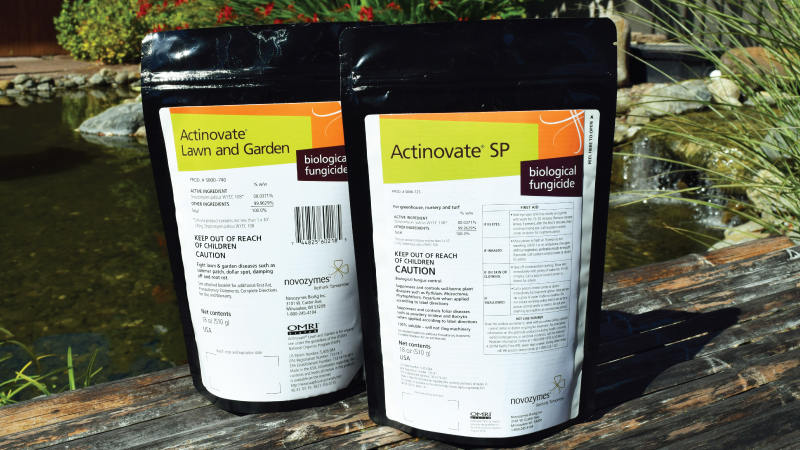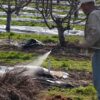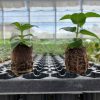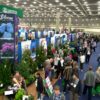Actinovate biological fungicides offer growers and home gardeners a very powerful and versatile Organic (OMRI Listed) tool to control fungal pathogens. Actinovate works just like other biological controls (the classic example of a biological control is the use of ladybugs to control aphids), only the organisms in Actinovate act on a microscopic level. Actinovate uses a natural enemy of fungal pathogens to keep these pathogens from destroying your crops. This natural enemy is a beneficial bacteria called Streptomyces lydicus WYEC 108, which is a naturally occurring soil bacterium that was originally isolated from the roots of a linseed plant in England, and patented worldwide. Actinovate is effective and versatile, utilized both indoors and outdoors, in markets including greenhouse, nursery, landscaping, turf, and homeowners.
How does Actinovate protect against fungal pathogens?
Actinovate can be utilized to combat fungal soil diseases, as well as foliar diseases. The organism within Actinovate colonizes plant structures in a beneficial symbiotic manner, when introduced into the root zone or applied to foliage. The Streptomyces lydicus spores germinate and form a mutually beneficial relationship within the rhizosphere of plants by feeding off the plant’s waste and secreting beneficial byproducts, such as Chitinase to break down fungal walls, byproducts that kill or repel other microbes, and iron carriers to starve competing microbes. Essentially, the S. lydicus feeds off the root’s secretions, and discharges toxins that keep other microbes (including pathogens) out. This assortment of byproducts and toxins discharged by S. lydicus means that Actinovate utilizes several modes of anti-fungal action to protect plants, lawns, and gardens from pathogens, rather than relying on a single mode of action as many other fungicides do.
What pathogens can Actinovate help control against?
Similar to a probiotic used to keep our own digestive systems in healthy balance, Actinovate works within the root zone microbiome to keep the system healthy and in-balance. Actinovate can be used on annual and perennial bedding plants and flowers, roses, potted flowers, foliage plants, trees, shrubs, and lawns located in homes, greenhouses, and home landscapes, as well as fruits including tree fruits, berries, and melons, nuts including a wide variety of tree nuts, and vegetables including leafy vegetables, root crops, cole crops, peppers, and tomatoes.
Actinovate’s S. lydicus organism will actively control against several common soil pathogens, such as Damping Off Fungus, Root Rot, Turf Brown Patch, Pythium, Rhizoctonia, Phytophthora, Fusarium, Verticillium, Sclerotinia, and many others.
In foliar applications, Actinovate will suppress Downy Mildew, Gray Mold, Powdery Mildew, Botrytus, Phytomatotricum, Sclerotinia, Alternaria, and more.
When should Actinovate be applied?
As with most biological controls, it is best to use Actinovate as a preventative tool, rather than curative treatment. For best results, apply Actinovate as early as possible to the plant’s root system, and reapply every 2-12 weeks as needed. In foliar applications, it is best to apply prior to disease development, or at the first signs of pathogen infection, and repeat at 7-14 day intervals to protect new foliage.
Actinovate is relatively safe when compared with many other fungicides, though caution is advised when using any pesticide. Please read the label thoroughly for all precautionary statements and PPE requirements. When sprayed onto foliage or used in chemigation via sprinkler or other spray irrigation, the re-entry period is only one hour, or once the solution has dried. Actinovate can be applied up to and including the day of harvest, so the pre-harvest interval is not a concern. Always clean application equipment prior to use of this product, and use the prepared Actinovate solution within 4 hours of preparation.
How can Growers and Gardeners apply Actinovate?
Actinovate is a soluble powder which can be added to water to create a solution and then applied to the plant’s root zone or foliage using the applications below.
For rhizosphere, or root-zone applications, the soil drench should contain 4-6 ounces of Actinovate per 100 gallons of water (1 teaspoon per 2 gallons of water for smaller quantities). This solution can be watered into damp soils, applied to pots, base of plants, root balls, or applied to the root zone by watering the substrate with Actinovate solution until the soil is completely saturated without creating runoff (generally 1 gallon of solution per cubic foot of substrate). In greenhouses and nurseries, Actinovate can be applied to the root zone via drip or flood chemigation using the rate of 1-12 ounces of Actinovate per 10-200 gallons of water, depending on desired application. For soil chemigation, apply the solution only through pressurized drench (flood) or drip (trickle) systems, micro irrigation such as spaghetti tube or individual tube irrigation, hand-held calibrated irrigation equipment such as hand-held wand with injector, or ebb and flow systems.
For foliar applications, dissolve 6-12 ounces of Actinovate into 50-100 gallons of water. Growers or gardeners can use a pump bottle, hand-held pump, backpack, or similar spray equipment to spray leaves, stems, and new shoots to wet, but not quite to run-off, providing complete coverage of the entire plant. In greenhouses and nurseries, Actinovate can be applied to the foliage via chemigation using the rate of 1-12 ounces of Actinovate per 10-200 gallons of water, depending on desired application. For foliar chemigation, apply the solution only through overhead boom and mist-type systems or sprinklers such as impact or micro-sprinklers. For best results in foliar applications, use a non-ionic spreader-sticker in conjunction with Actinovate application.
Always refer to product label for complete instructions, precautions, safety, and storage and handling before use.
Can Actinovate be part of an IPM program?
Actinovate is a great addition to any Integrated Pest Management program, and can be used safely and effectively alongside beneficial fungi, such as mycorrhizal inoculant products. Actinovate can also be used safely and effectively alongside a rotation of traditional fungicides. Also, Actinovate does not need to be rotated, and can be used year-after-year, season-after-season, as unlike other fungicides, there are no pathogen resistance issues caused by prolonged or repeated use of biological solutions such as S. lydicus. Actinovate is OMRI-Listed as an organic input, therefore, it is a great resource for organic growers and gardeners for organic control of fungal pathogens. Additionally, Actinovate is Pollinator Safe, as trials have shown that exposure to Actinovate had no adverse effects on honeybees.
What Actinovate products are available for Professional Growers and Home Gardeners?
Actinovate is a proven technology that has been utilized by growers, farmers, landscapers, turf managers, and home gardeners with confirmed success for many years. Professional growers, turf managers, and landscapers can utilize Actinovate SP for nursery and greenhouse applications. Actinovate SP is available in 18 oz. packages, and has a 6-month shelf life. Home Gardeners and Lawn and Garden professionals can utilize Actinovate Lawn and Garden, which is available in 18 oz. packages, 2 oz. packages, and 0.7 oz. packages, and also has a shelf life of 6 months.
Where can I find these products and learn more about how to use them?
These Actinovate biological fungicides for Professional Growers and Home Gardeners are available through distributors in the US and Canada. The best way to determine where you can get your hands on Actinovate SP or Actinovate Lawn and Garden to try in your own greenhouse or nursery, or home lawn and garden, is to contact your local distributor. If you have problems locating a distributor or need further information, contact Mycorrhizal Applications, who can point you towards a distributor in your region. Their information is available online at www.mycorrhizae.com, or you can reach the Mycorrhizal Applications sales staff by calling (541) 476-3985 or emailing inquiries@mycorrhizae.com.
Still have questions?
Please review our Actinovate Frequently Asked Questions section for more info: https://mycorrhizae.com/actinovate-faqs/
© 2018, by Mycorrhizal Applications LLC







